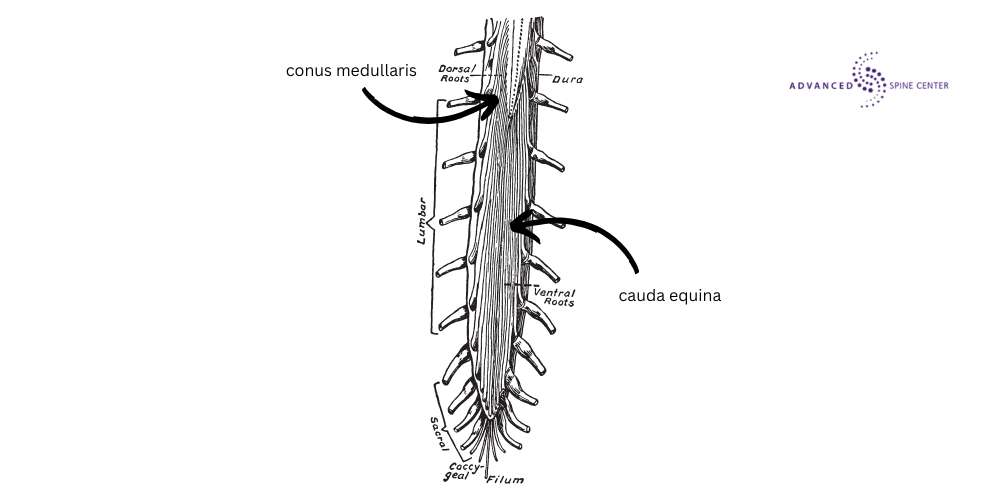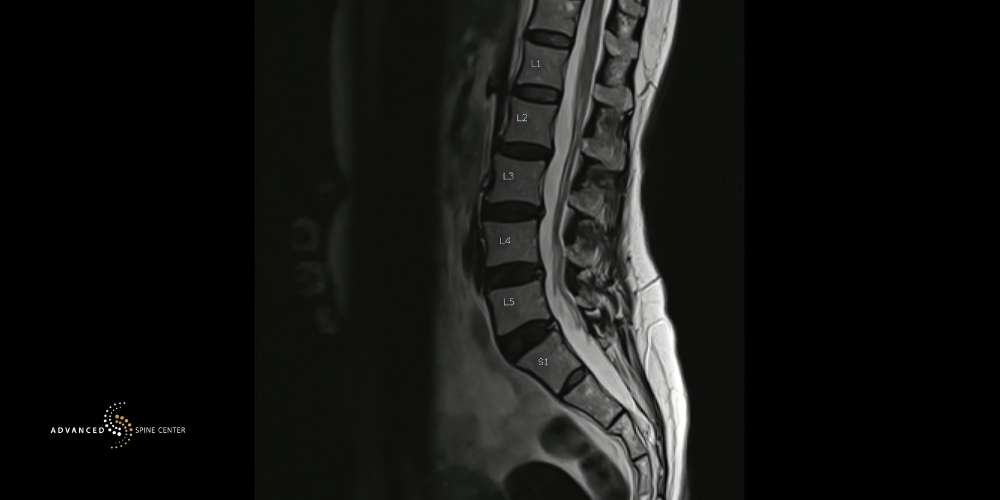Specialties

If you’re looking for expert spinal care and advanced cauda equina syndrome treatment in Plano, TX, look no further than the Advanced Spine Center. Our specialized orthopedic spine surgery clinic offers comprehensive solutions tailored to address the complex needs of CES patients.
From precise diagnostic evaluations using state-of-the-art imaging technology to personalized treatment plans, our team of spine specialists is dedicated to restoring your quality of life. Whether you’re experiencing early symptoms or seeking urgent surgical intervention, trust Advanced Spine Center for compassionate care and superior outcomes in managing cauda equina syndrome. Call 972-499-5457 today to schedule an appointment with us.
Cauda Equina Anatomy
The cauda equina, Latin for “horse’s tail,” is a bundle of spinal nerves and nerve roots that originate from the lower end of the spinal cord, specifically from the L2 to S5 vertebrae. It is so named because its appearance resembles a horse’s tail.
These nerves extend down the vertebral spinal canal and continue through the lumbar, sacral, and coccygeal regions, innervating the lower limbs, pelvic organs, and perineum. The cauda equina is crucial for motor and sensory functions in the lower body and controls bowel and bladder functions.
What Is Cauda Equina Syndrome?
Cauda equina syndrome (CES) is a severe neurological condition resulting from the compression of the cauda equina nerves at the lower end of the spinal cord. This syndrome can be caused by herniated discs, tumors, spinal stenosis, infections, or trauma. CES is characterized by symptoms such as severe lower back pain, saddle anesthesia (numbness in the areas that would sit on a saddle), bowel and bladder dysfunction, and varying degrees of motor and sensory loss in the lower extremities. It is a medical emergency that requires prompt surgical intervention to prevent permanent damage and restore function.
Conus Medullaris vs Cauda Equina

The cauda equina and the conus medullaris are distinct structures within the lower spinal region. The conus medullaris is the tapered, cone-shaped end of the spinal cord, typically located around the L1-L2 vertebral level in adults. Below the conus medullaris, the spinal cord ends and the cauda equina begins.
The cauda equina is a bundle of spinal nerves and nerve roots that extend from the conus medullaris, descending through the lumbar and sacral spine. While the conus medullaris marks the end of the spinal cord proper, the cauda equina consists of individual nerve roots that continue to innervate the lower body, including the legs, bladder, and bowel.
When the cauda equina is damaged in some way, this can cause a rare but serious disorder called cauda equina syndrome.
Cauda Equina Syndrome Symptoms
The symptoms of cauda equina syndrome can be quite severe and debilitating. Typical symptoms of cauda equina syndrome include the following.
- Severe lower back pain
- Saddle anesthesia (numbness or tingling in the inner thighs, buttocks, and perineum)
- Significant bowel and bladder function problems, such as urinary retention or incontinence
- Bowel incontinence
- Sexual dysfunction
- Reduction or loss of motor and sensory function in the lower limbs
Early Symptoms of Cauda Equina Syndrome
Early symptoms of cauda equina syndrome (CES) often include lower back pain that may radiate down the legs (sciatica), numbness or tingling in the saddle area (inner thighs, buttocks, and perineum), and weakness in the lower extremities. Patients might also notice changes in bladder or bowel function, such as difficulty starting or stopping urination, a sensation of incomplete bladder emptying, or loss of bowel control.
Where Does Cauda Equina Start?
The cauda equina starts at the lower end of the spinal cord, specifically from the conus medullaris, which is located around the L1-L2 vertebral level in adults. From this point, the cauda equina extends downward within the spinal column, consisting of a bundle of lumbar, sacral, and coccygeal nerve roots that continue to travel through the lumbar spine and sacral regions.
How Rare Is Cauda Equina Syndrome?

Cauda equina syndrome is a relatively uncommon condition that affects approximately 1 in every 65,000 people. Even though it is rare, it’s important to understand the signs and symptoms of the condition.
Cauda Equina Syndrome Red Flags
Cauda equina syndrome has certain red flags that can indicate a need for immediate medical intervention. These red flags include bladder and bowel dysfunction, pain or altered sensation in the legs, loss of sexual sensation, and numbness in the saddle area. Failing to address cauda equina syndrome promptly could cause serious damage, including permanent paralysis.
Cauda Equina Syndrome Causes
Cauda equina syndrome (CES) is caused by compression or damage to the cauda equina nerves at the lower end of the spinal cord. Common causes include lumbar disc herniation, spinal stenosis (narrowing of the spinal canal), tumors, infections, trauma (such as fractures or dislocations), and inflammatory conditions. Less frequently, CES can result from spinal hemorrhage or complications from spinal surgery.
What Are the Stages of Cauda Equina Syndrome?
Cauda equina syndrome (CES) typically progresses through several stages, each marked by increasingly severe symptoms. These stages are as follows.
- Early Stage: Lower back pain, sciatica, sensory changes in the saddle region, and mild weakness in the legs.
- Acute Stage: Severe lower back pain, increased numbness and tingling in the saddle area, significant muscle weakness in the legs, changes in bladder and bowel function, and changes in urinary and rectal function.
- Late Stage: Profound muscle weakness, possible paralysis in the lower extremities, complete loss of sensation in the saddle area, severe dysfunction of bowel and bladder control, and sexual dysfunction.
What Is the Cauda Equina Life Expectancy?
Cauda equina syndrome is not, in itself, a life-threatening condition. It generally does not affect one’s life expectancy. However, in many cases, cauda equina syndrome results in devastating long-term effects and can certainly change one’s life.
How to Diagnose Cauda Equina Syndrome

Cauda equina syndrome (CES) is diagnosed through a combination of clinical evaluation and imaging studies. A thorough neurological examination is conducted to assess motor and sensory function in the lower extremities, as well as bladder and bowel function. Imaging studies such as MRI (Magnetic Resonance Imaging) of the lumbar spine are crucial to visualize any compression or structural abnormalities affecting the cauda equina nerves. These scans help identify the cause of CES, such as herniated discs, tumors, or spinal stenosis.
Cauda Equina Syndrome Test
Generally speaking, there is no specific test for cauda equina syndrome. However, an orthopedic spine surgeon will generally begin with a physical exam to assess the patient’s stability, strength, sensation, and reflexes. Then, they may order an MRI for a clearer view of the body’s tissues and nerves.
Cauda Equina Syndrome Treatments in Plano, TX
The treatment for cauda equina syndrome (CES) depends on the severity of symptoms and the underlying cause.
Cauda Equina Syndrome Treatment Without Surgery in Plano, TX
In cases where CES is diagnosed early, and the symptoms are mild, conservative management may be attempted initially. This can include bed rest, pain management with medications, such as nonsteroidal anti-inflammatory drugs (NSAIDs) or opioids, and physical therapy to improve mobility and strengthen the back muscles.
However, it’s important to note that conservative treatment alone is typically not sufficient for severe cases of CES or when symptoms progress rapidly. A more severe case would be considered a medical emergency and may require spine surgery.
Cauda Equina Surgery in Plano, TX
Surgical intervention is the primary treatment for most cases of cauda equina syndrome that require immediate attention. The goal of surgery is to relieve pressure on the compressed nerve roots and prevent permanent neurological damage. The specific surgical approach depends on the underlying cause of CES, such as discectomy for herniated discs, prompt surgical decompression for spinal stenosis, or tumor resection for spinal tumors.
Surgery is usually performed urgently to restore function and improve outcomes. Post-surgical rehabilitation may include physical therapy to regain strength and mobility, as well as management of any residual symptoms or complications.
Contact the Advanced Spine Center for Cauda Equina Treatment in Plano, TX Today

At the Advanced Spine Center in Plano, TX, our commitment is to provide you with exceptional care and support throughout your journey with cauda equina syndrome. We understand the urgency and complexity of CES, and our team is here to guide you every step of the way—from initial evaluation to personalized treatment and rehabilitation.
With our expertise in orthopedic spine surgery and dedication to achieving the best possible outcomes, you can trust that you’re in capable hands. Contact us today to schedule a consultation and take the first step towards relieving your symptoms and reclaiming your life.


